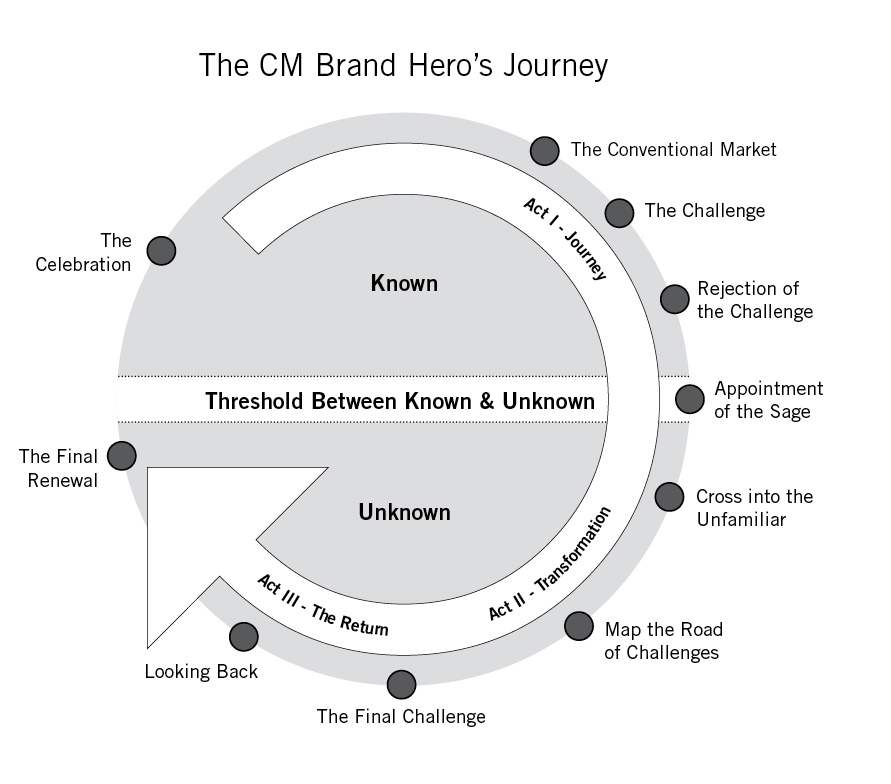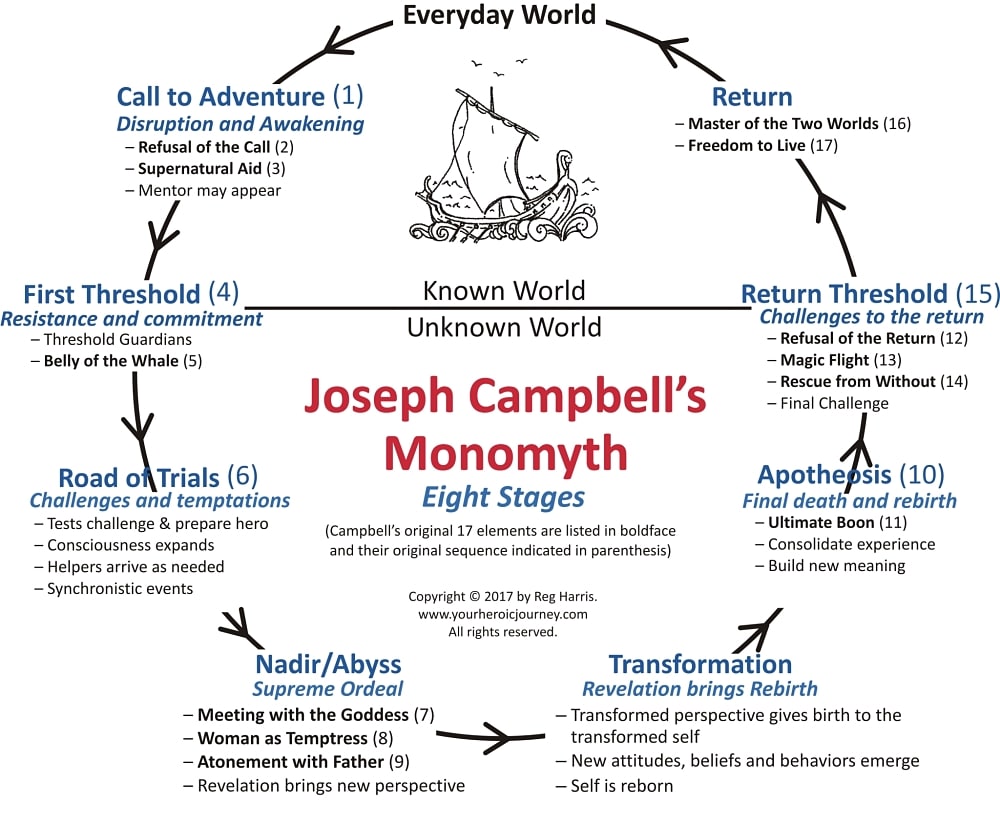Who doesn’t love a hero – especially in uncertain times? When content marketers harness the power of the “hero’s journey” to help their clients overcome incredible challenges, they can take brand storytelling to a whole new level.
It’s an incredible, business-building addition to your content marketing toolbox. Here’s more on the hero’s journey concept as well as three examples of the hero’s journey from brands that put on their capes and soared to new heights through their content.
What Is the Hero’s Journey?
In 1949, mythologist Joseph Campbell published a landmark book in his field, “The Hero with a Thousand Faces.” Inspired by renowned psychologist Carl Jung, Campbell put to pen what we’ve all known instinctively for thousands of years:
- Every story worth reading has a hero.
- Every hero shares a common journey – only the names, dates, and places differ.
Although the original hero’s journey has 17 stages, Content Marketing Institute’s Chief Strategy Advisor, Robert Rose, and his team distilled it down to ten stages that can turn your brand storytelling into sheer magic.
- The conventional market (originally, the “everyday world”)
- Facing a challenge
- Rejecting the challenge
- Appointing the sage
- Crossing into the unfamiliar
- Mapping the road of challenges
- Facing the final challenge
- Looking back at the changes you’ve undergone
- Looking forward to new challenges through a changed outlook
- Celebrating your victory

When you use this outline as a guide to create a piece of content – or even your entire content strategy – it takes your audience on their own hero’s journey, giving them a sense of camaraderie with your brand. Even more importantly, it lets them feel like a hero.
Whether you’re marketing to other businesses or directly to consumers, storytelling works. Statistics show that a story is 22 times more effective than sheer facts. It’s no wonder. Research shows that emotion is the paramount factor in most buying decisions.
Great content grabs its audience by its heartstrings, yet includes just enough facts to justify their decision. What could better cover both angles than a journey to overcome challenges to experience success – the hero’s journey? Here are some brands that have rocked the hero’s journey on their road to content marketing success.
Coca-Cola
Islamophobia was still a thing back in 2018 – at least in the everyday world, or the conventional market, as Rose put it. Not outright hate mind you, for the most part, but a fear driven by ignorance. In a simple two-minute video, Coca-Cola transformed that fear into a hero’s journey.
First, it sets the scene. Music plays as text runs across the screen, explaining that during Ramadan, observant Muslims eat or drink nothing from before sunrise until after sunset. Cut to a hazy summer evening, as a hijab-wearing woman runs to catch the bus to take her home from work.
She misses the bus, of course – for this is a hero’s journey. She walks along the street, growing thirstier with each step, sadder with every sideways glance.
A jogger finishes her course, stopping to buy a Coke from a street-side stand. She notices the hijab-clad woman shaking her head at the inhumanity of the passers-by – a challenge. She doesn’t know this woman. Should she take a chance?
At first, she orders a single Coke – momentarily rejecting the challenge. Then, in a split second, glancing again at the Muslim woman, she orders two. The sage? Her own empathy.
The Muslim woman pauses, leans onto a sidewalk railing, and glances at the sun as it’s almost down. All she has are two dry dates – the traditional way Muslims across the world replenish their blood sugar before their traditional evening meal. The jogger, crossing into the unfamiliar, joins her. In the jogger’s mind, thoughts must race through – the challenges.
“What if she won’t accept my gift?” “What if it’s too early?” “Are Muslims even allowed to accept gifts of food from a non-Muslim?” “Is Coke OK for Muslims to drink? I might have heard that Muslims couldn’t drink caffeinated beverages…or was that Mormons?” One can feel the tension in her mind as the jogger maps out and faces the final challenge – does she offer, or doesn’t she?
All in the space of seconds. She offers the Muslim woman a Coke. As the sun sets, the skeptical Muslim and the jogger look back at the cultural barriers they both have overcome – the changes that turned strangers from different cultural backgrounds into instant friends. With changed outlooks on humanity from both vantage points, the two women celebrate a spectacular sunset.
That video isn’t a one-off for the iconic beverage brand. Throughout its history, it has used various versions of the hero’s journey, sometimes positioning itself as the sage, at other times allowing another to take that role. At times, such as its post-Thanksgiving “pause that refreshes” video, it even takes on the role of hero, staving off food comas so that people can watch the football games after the feast.
Huggies
In today’s world of social distancing, it’s heartwarming to remember the power of human connection, particularly at the start of life. Here’s a little reminder that we’ll someday return to that connected world.
In 2016, Huggies’ Canadian branch needed content that made Huggies-using mums into heroes. With a competitor that had 100 percent of Canada’s hospitals as its clients, Huggies faced a hero’s journey of its own.
In this case, the conventional market was itself the challenge. However, Huggies’ content team pressed on. Playing on its own brand name – Huggies, the team explored the possibilities of using that motif to guide their content.
They dug into the research on hugs. Even as Canada’s mums faced the challenge of bucking the tide to choose Huggies – and many of them rejecting that challenge for the status quo, the sage nevertheless spoke.
The Huggies team discovered 600 studies that revealed that hugs – and other skin-to-skin bonding – help to boost an infant’s immune system, help the brain develop, and even stabilize a baby’s vital signs. With blog posts, articles, and other educational campaigns, the brand went to work to “educate mothers on the importance of skin-to-skin contact with their babies.”
Then the team crossed over into the unfamiliar. They recruited volunteers to serve as “huggers” to provide babies whose parents could not hug them for whatever reason. Facing off skeptical hospital administrators with a fistful of data, the team pressed on.
It worked. It went against the grain of traditional marketing, but it worked. Turning the infants’ parents into hugging heroes – boosting their children’s development with every embrace – was a winning formula.

Not only were the parents better able to conquer new challenges through their Huggies-sourced insights, but the content team had cause for celebration itself. Sales soared by 30 percent, and engagement rose three times over the industry’s benchmarks.
Airbnb
Travelers often need heroes. Whether it’s arriving at +2:00 a.m. after a harrowing journey through a blizzard or navigating their way in a foreign land with only Google Translate, there’s no better industry for a brand to earn customer loyalty than in travel.
Airbnb itself, however, faced a conventional market of pricey hotels and uncaring customer service. Its customers might want a homier approach but were fearful of staying in a stranger’s home.
Enter Airbnb’s content team. After the brand’s initial hands-off approach – as simply a booking service – it rebranded itself in a more customer-focused approach – its “Belong Anywhere” campaign.
Intent on positioning the brand as its customers’ knight in shining armor, it faced its challenges head-on. Putting the customer – not its brand – at the center, it strode forth to offer travelers more than just a roof over their head.
With the help of its sages (local homeowners and boutique hotels), the team crossed into rarely traveled territory, allowing property owners to tell the stories of their communities. Whether it’s that out-of-the-way spot in Istanbul that has killer lamb kebabs or sparkling Atlantic beaches that rarely see human traffic, these local experts help travelers make the most out of every trip.
Conquering the challenges of the unknown, the company leveraged short videos to give customers a glimpse into their hosts’ lives and properties, making them feel familiar with their home away from home before they even arrive.
Its efforts have not only conquered its customers’ challenges, but it has also taken the brand from a quirky alternative to hotel stays to a household word.
With 246,000 YouTube subscribers and counting, that’s something to celebrate. That’s the power of the hero’s journey – and it can work for you as well as it did for these brands.
Your brand’s hero’s journey needs only one thing to propel it along its way – a way to spread the word that doesn’t get in the way of your regular work. A comprehensive content marketing platform can help.
With content automation capabilities that can integrate every aspect of your marketing, it’s like having an “easy button” to publish content on the right channels to the right people at the tight time. Here at DivvyHQ, we want to let you see how the magic of an automated hero’s journey works for yourself.
And because we believe in the hero’s journey – we’re offering you a 14-day trial for free. Get started with your hero’s journey today.
